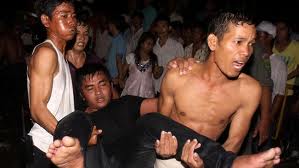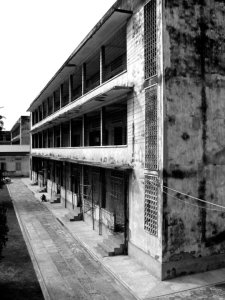‘’Let me reassure that the Kingdom of Cambodia a country with independence, neutrality, peace, freedom, democracy and human rights as you all have seen, shall be existing with no end.’’ Prime Minister Hun Sen
Continuing with extracts from my diary.
27th November
Today I met a journalist for the Phnom Penh Post and was given all the gossip about the country. Cambodia has a dark side which no one admits to and no foreigner sees. I was quickly told that journalism is a dangerous profession: some journalists have been sent to prison for ‘slander’. He told me about stories he was working on, stories which would be published abroad. These stories will be on the HIV problem in Cambodia; he found out through NGO contacts, and drunken politicians at functions, that Cambodia has a habit of lying about the number of HIV and AIDS cases: the government have worked out that the higher the number the more money from charities and governments they will get. Also, this aid money was never passed down to those who needed it. The rich kept themselves rich, and the poor remained poor and in poverty.
We continued the conversation over dinner (fried ants are gorgeous) and also learnt that the lake in Phnom Penh, the one that stops the city from flooding every wet season, has been sold to a foreign company who were going to fill it in to make a shopping centre. And to replace the lake, they were going to build a new one and that they picked a place, not outside Phnom Penh, but right over a housing estate where a lot of poor people lived. Another article being written was about how the families and businesses in that area weren’t being given compensation; they were being forced to leave and were being made homeless. Apparently, the company had given the government money for compensation, but surprise surprise, it wasn’t passed down.
We also got chatting about the water festival. The journalist went on to explain about Diamond island, how it used to be full of homes and businesses but (this sounds familiar) was bought by a company who evicted everyone (again left them homeless) and built a theme park. The yearly water festival was to be held there to show off the new renovated island, and the news that the island had changed spread over Cambodia, so more people from across the country turned up than were expected. The main bridge rocks slightly and there were a large number of people from the countryside who didn’t realise the bridge naturally did this, so they got spooked and started the stampede. It wasn’t the story I heard on BBC News before I left about how some people were electrocuted and fainted which caused panic. The journalist then went on to talk about the compensation system that had been put in place for the victims: if a family had one or more person who died in the incident, they got paid $50. If a family had one or more person who got injured, they were paid $100. Compensation wasn’t per person but instead per household, and barely covered medical and funeral costs for one person let alone any additional family members.
28th November
As I was leaving Phnom Penh the day after next, I decided to pay the tuk-tuk driver for the trip to S-21, the Killing Fields and today’s trip. I was already advised by the guesthouse owner that I should pay no more than $35. The tuk-tuk driver took me to one side and said that for me he would give me a special price. He said that because he hadn’t laid a finger on me I was to pay him what worked out to be £200. I thought he was joking, and he said that if I didn’t pay him I was to remember that he had access to my drinks in the guesthouse (true, as he got them from the kitchen fridge every morning) and that he also had access to my room. He said that if I didn’t pay he wouldn’t hesitate and told me that my embassy wouldn’t care if I was raped and the police wouldn’t care unless I paid them to look into the matter. I still thought he was joking, and he told me to go up to my room as he has made a point. When I unlocked my door my bed was covered with around ten massive spiders (Cambodia doesn’t do normal sized spiders). I was staying in a twin room, and when I have breakfast the owner’s wife makes the bed and has a sweep. I also double check every morning that I have locked the door. Yet, the driver knew exactly which of the two beds I was sleeping on and placed the spiders on the right one. I hate spiders, and these were massive, I went and got the hotel owner who thought I was joking, saw them, then went to get a bucket. Whilst he was sticking them in the bucket he was telling me which ones gave nasty bites, which ones were poisonous and which ones look more harmful than that they actually are. I did however quickly get the driver’s point and decided to pay him. I never saw him again.
Whilst at dinner with my new journalist friend I told him briefly what had happened and they told me about an American girl a few weeks back who was raped – she went to the police and was sent away because she was white and therefore must’ve been asking for it. He also told me white women were targeted upon more, because Cambodians don’t like black skin -white is seen as more exotic and Westerners are seen as incredibly wealthy. It is an easy way for them to make money and if a woman refused to pay then the men would take another form of payment.
Cambodia breaks my heart. Politically and socially, it’s completely messed up. The Human Rights Watch have done a number of reports into the political corruption and human rights abuses to Cambodian citizens. Amnesty International have also produced lots of statistics on crime against women in Cambodia. More needs to be done to improve the situation, instead the world are happy to ignore the problem.
Cambodia receives up to $7omillion in aid every year from the World Bank alone. There are over 3,000 NGOs and yet the country has been stuck in a rut since the Khmer Rouge regime in the 1970s. Something has to change.
Articles and reports about abuses: http://www.docstoc.com/docs/123212617/Cambodia-Rape-report
http://www.guardian.co.uk/world/2010/oct/28/raped-beaten-killed-cambodia-detention-camp
http://www.hrw.org/asia/cambodia
http://www.guardian.co.uk/global-development/2011/aug/26/donors-asked-to-review-cambodia-aid




